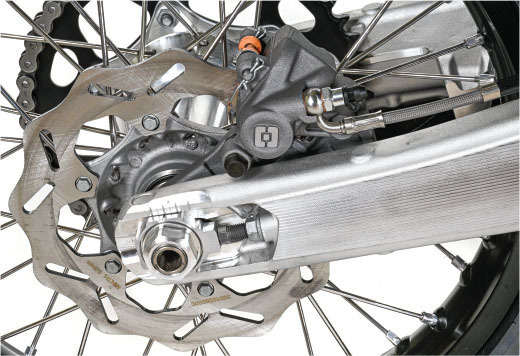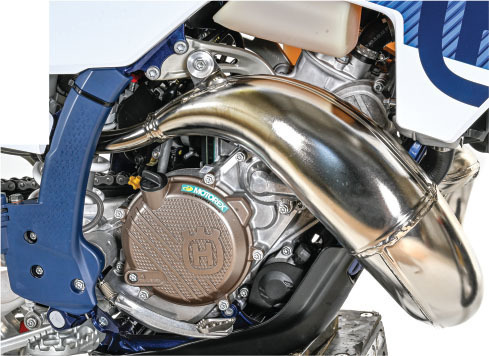America loves horsepower. That goes for everything from top-fuel dragsters to SpaceX rockets. The infatuation has been a staple of U.S. culture from the start, but it has resulted in casualties along the way. The small-displacement trail bike comes to mind. Over the years our Penton and Hodaka 100s have given way to 450s and 500s. The Husqvarna TE150 is a serious attempt at bringing back a whole class of off-road bikes that we never should have left behind.

GENESIS OF A LIGHTWEIGHT
The Husqvarna TE150 is all new this year. It has a new chassis, a new motor, a new electronic power valve and a new throttle-body fuel-injection system. If you look back at the history of this bike, it’s clear that Husqvarna has been adjusting its purpose somewhat. The first Husky 150 in 2017 was a carbureted two-stroke with a kickstarter and an electric starter that arrived right at the end of the 200cc two-stroke era in the U.S. The Kawasaki KDX200 had been gone for a long time, and the KTM 200XC-W had only recently been discontinued. The 150 wasn’t necessarily a good replacement for a 200; it was faster, but didn’t have the low end or the smooth power delivery. It had a pretty good motor for racing. With a little suspension work, it was even at home on a motocross course. The next version had transfer port injection in 2020. That was tamed down a little on top, but it still didn’t have the low-end power that those old 200 fans were looking for. Now, with the new TBI motor, it’s a more legitimate offering for those guys.
This motor is based loosely on the Husky TC125 motocross bike that arrived last year. It might be the most computerized dirt bike on the market. By that, we mean that the power valve, the spark advance and the fuel delivery are all tied to rpm and throttle opening in a complex matrix of programming. When you add in input from sensors for temperature, gear positions and air density, it probably has more megabytes of programming than anything on Apollo 11. The cylinder, head and displacement are different from the TC125 to give it an off-road powerband, and the 6-speed gearbox has different gear ratios.
The chassis is new, too, and the big news is the new WP Xact coil-spring fork, replacing the open-cartridge Xplor fork on last year’s TE150. Obviously, the new fork is structurally different from the Xact air fork, not only because it has a spring, but because of its off-road valving; however, it is still a closed-cartridge design. In the rear, the bike has linkage connected to an Xplor shock, which is slightly less sophisticated than the one on the TC125. The spring rates are the same on both bikes. For brakes and hydraulics, the TX uses Braktec components. Of course, the TE also has a larger fuel tank, a headlight, a kickstand and an 18-inch rear wheel. All that makes it a bit heavier than the typical 125 two-stroke. It’s 220 pounds without fuel.
TRAIL GOAT
On the trail, it’s apparent that this bike is no 125. It has amazing pulling power down low. You can drag it down to idle and open the throttle without any hesitation whatsoever. Even on rocky uphill trails you learn to trust it. You don’t have to cover the clutch and It won’t stall. In that respect it truly is a miniature 300 two-stroke. It doesn’t have the sheer pulling power of a bigger bike, but the mannerisms are pretty much the same. The meat of the power hits fairly hard, more or less like a 125, but when it’s done, it’s done. The new TBI 150 might rev a little higher than the transfer-port injection version, but it’s still no screamer. That’s a bummer if you think you’re going to take the bike on a motocross course like the old carbureted version. It doesn’t have the peak power or the revs to make that a good fit. The Husky does have a map switch like the other new-generation Husky two-strokes, but it serves a different purpose. On the TX300 and the TC250, the green map has a much harder hit and more power. The green map on this bike just makes the motor slightly richer, which is useful in sand and any conditions where the motor is under a big load.
So, is it the modern-day 200? Let’s not get too misty eyed about the 200s of the old days. They were great in their day, but they wouldn’t be much of a hit measured against modern standards. The Kawasaki KDX200 of the ’90s was heavier and much, much slower. So was the KTM 200 that came later. In every metric, the TE150 outperforms those bikes. It has a much more difficult time dealing with modern 200s—yes, there are a few. The Beta 200RR is the one we have in the shop right now, and it’s a very different motorcycle. That bike has almost the same weight (223 pounds) and similar peak horsepower. But, the Beta makes all of its power down low; it’s even less of a screamer than the TE150. The Beta is truly a trail bike, whereas the Husky is kind of a race/trail hybrid.



TRAIL TRICKS
One area where the Husky excels is in the suspension department. The fork is a big upgrade over the previous version, and we might even like it better than the Xact air fork. The new TE150 isn’t nearly as soft as the old version, and it’s also well balanced for aggressive off-road riding with an intermediate or expert rider who weighs over 150 pounds. If you’re a younger rider just transitioning to a bigger bike, it might be a little stiff. That brings up the question: who is this bike for? The bottom line is that it’s a great, general-purpose off-road bike for everyone. Older riders tend to go for big bikes, whereas this would be a much better choice for 90 percent of the trails they ride. It’s agile and easy to ride, and you always feel like it’s helping you become a better rider. The places it doesn’t like are wide-open spaces and steep hills. The 300s and 450s are hard to beat in those situations.
In terms of trail technology, the TE is vastly superior to those lightweight two-strokes of old. First of all, it has oil injection. We know that technology is as old as two-strokes themselves, but for some reason, we liked mixing oil in gas back then. The Husky also has a much more powerful LED headlight, excellent handguards, a ProTaper handlebar and fuel range of well over 50 miles with just a capacity of 2.25 gallons. Carbureted two-strokes were much more greedy with fuel.
The one key factor that Husqvarna missed in its attempt at recapturing the lightweight trail bike legacy is value. The TE150 has a suggested retail price of $10,199. Something went seriously askew in Husqvarna’s head office; the TC125 motocross bike has the same technology and most of the parts, but sells for $8,199. If you want to get really depressed, the Kawasaki KDX200 sold for $2,000 in 1990. Even today’s inflation can’t account for that.
Still, it’s not our job to manage your money. All we can say is that the TE150 is an excellent bike with technology that shows the path to the future. It isn’t a modern-day 200, but it is its own entity that one day might create a legacy of its own.





Comments are closed.